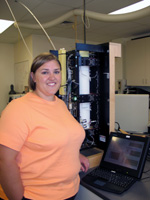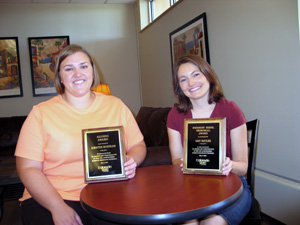Atmospheric Science Grad Students Conduct Award Winning Research
 |
|
Amy Butler
|
Awarded the 2007 Herbert Riehl Memorial Scholarship for best technical manuscript, atmospheric science Ph.D. student Amy Butler is tackling the well-known issue of carbon dioxide in a region with relatively little research in the area, the Southern Ocean. Located in the Southern Hemisphere, the Southern Ocean is thought to act as a sink for human-induced carbon dioxide emissions. Using observations of carbon dioxide from the National Oceanic and Atmospheric Administration (NOAA) Global Monitoring Division based in Boulder, Butler is working to understand how climate variability affects the carbon dioxide levels circulating over the Antarctic Peninsula, and surrounding ocean.
The first study of its kind to demonstrate a relationship between observed variations in the rate of change of carbon dioxide over the peninsula and large-scale climate variability, the study will help scientists to understand what drives fluxes of carbon dioxide from the Southern Ocean from month to month. Specifically, this study shows that an increase in the westerly winds around Antarctica is significantly related to an observed increase in carbon dioxide over the Antarctic Peninsula. Ultimately, Butler hopes that this relationship may indicate how trends in climate circulation will affect the overall ability of the Southern Ocean to take up carbon dioxide over longer time periods.
Current climate models indicate that an increase in the westerly winds near Antarctica may continue in the future due to ozone depletion and greenhouse gases. Based on Butler's research, an increase in the westerly winds could mean more carbon dioxide outgassed from the high-latitude Southern Ocean, mitigating the ability of the Southern Ocean to take up human-induced carbon dioxide.
Butler's work titled, "Observed Relationships between the Southern Annular Mode and Atmospheric Carbon Dioxide," will be featured in the journal Global Biogeochemical Cycles, and is currently in press. A double major in physics and astrophysics at the University of Colorado in Boulder prior to joining CSU, Butler ideally would like to continue her climate research at NOAA or the National Center for Atmospheric Research (NCAR) after earning her Ph.D. under Dr. David Thompson.
 |
|
Kirsten Koehler |
Working in the opposite hemisphere, Ph.D. student Kirsten Koehler was recently rewarded for her work on atmospheric issues plaguing California. The byproduct of source water diversion in 1913, Owens Lake has been a dry lakebed in the arid desert of southeastern California since 1926. Today, this region is the largest contributor of particulate matter, measuring less than 10 microns in diameter, in the western hemisphere. Particulate matter or aerosols-- small particles or liquid droplets suspended in our atmosphere-- have been linked to poor air quality, adverse health effects and dust storms plaguing the area.
According to Koehler, aerosols have also been shown to influence cloud formation, one of the largest uncertainties in determining global climate change. By measuring interactions of aerosols with water vapor at differing temperatures and relative humidities, Koehler has shown the potential impact of dust aerosols on visibility, the development of precipitation and the lifetime of clouds. Atmospheric aerosols are also believed to disturb the radiative balance in clouds, the incoming and outgoing radiation energy that warms and cools climate systems. Koehler hopes to accurately measure changes in clouds due to climate and aerosol concentration changes in the region, in order to determine their impact on cloud formation and the climate.
Koehler is the 2007 recipient of the Department of Atmospheric Science Alumni Award for Outstanding Research by a Senior Ph.D. After earning her doctorate under Dr. Sonia Kreidenweis, she would like to continue her research at NCAR or join academia as a professor or research scientist.
Both Koehler and Butler were honored this past spring in an annual awards ceremony, where each presented their research in a 20-minute talk. Candidates for both awards were nominated by a Department of Atmospheric Science faculty member, and were selected by a faculty committee.
 |
To learn more about the atmospheric science program at Colorado State University please visit http://www.atmos.colostate.edu/.